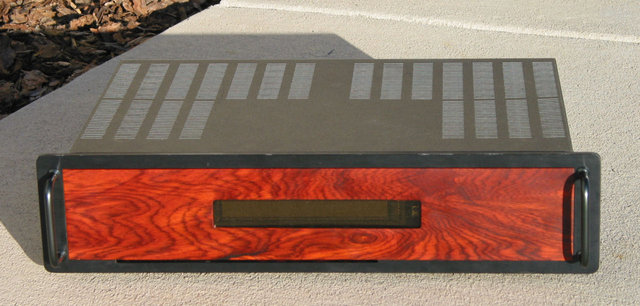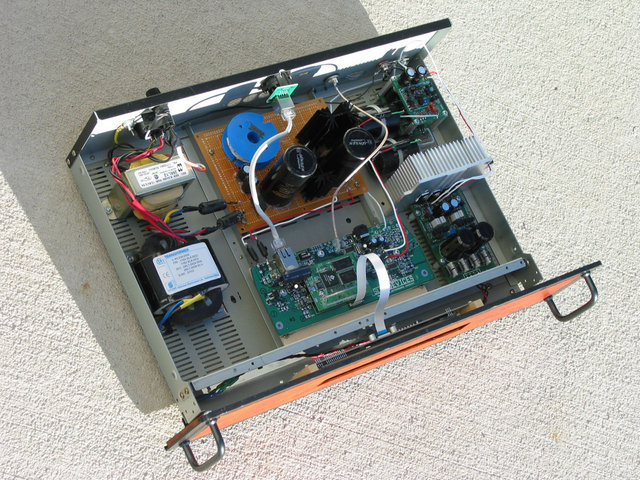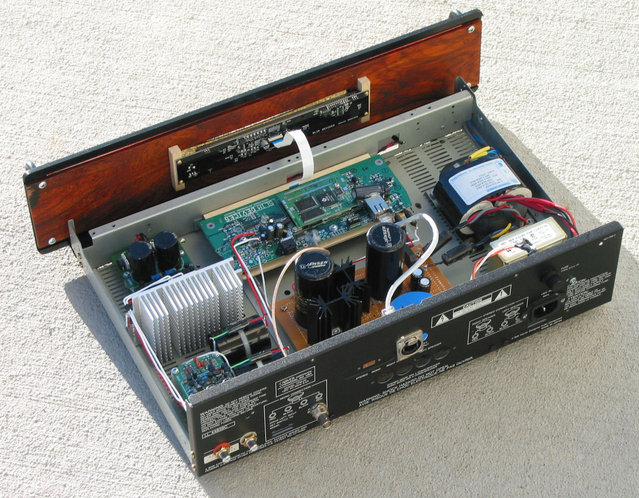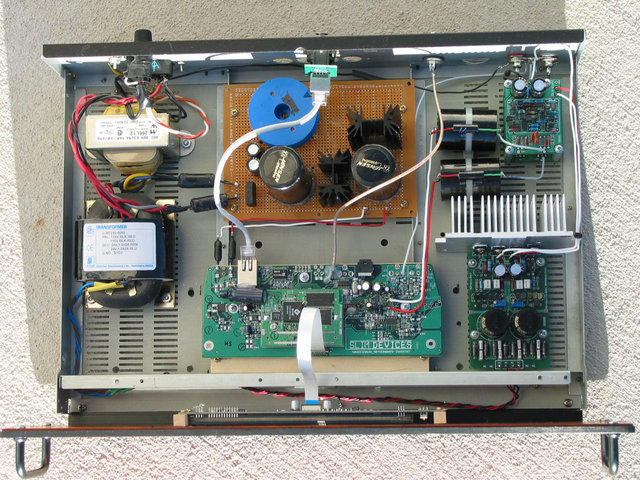I finally made the time to put my SB2, PS and Burson buffer into a single chassis. I reused an old Carver power amp chassis, the same one I had built the PS into the first time. I'm reasonably happy with the outcome but since the chassis was originally meant for an amp there are a few extra holes and the amp chassis is about 10 years old, so there are some scratches and other wear marks but overall not horrible.
The original front panel was plastic sitting inside of anodized aluminum. This made it look like it had a beefy, audiophile style panel but of course it was not. Brad Judy gave me some veneer and some 1/4" thick cocobolo when I saw him at RMAF. What can I say but thanks! Brad, I hope you like what I did with the cocobolo.

Since the aluminum of the front panel was just a frame, I cut a piece of cocobolo that would just fit in the frame width wise and the rabbeted the ends with a dado head so the cocobolo was flush with the aluminum frame. I made a template from 1/4" ply and used a router with guide bushings to make the cutout for the display. I reused the original display window from the SB2 though I did make the recess for it as deep as I dared. It sits about 1/16" from the front of the panel. I noticed today after taking the photos that the middle of the window is bowed in. I only put glue on the four corners. I'll have to take it apart and add a little to the middle to make it look right. That's not so bad as I can put on a couple more coats of Tung oil while it's apart.

As can been seen in the photo, there is a small gap on the left side between the wood and the aluminum frame. This was part of the frame and I decided to just leave it as it's not very visible unless you are at eye level and the piece of cocobolo I had was barely wide enough to fill the opening.
As for the electrics. The SB PS is pretty much like it was before with the addition of a pre-regulator floating 2.5V above the output. I tried adding a choke between the diodes and the first PS cap but reusing an old JM Labs speaker inductor was not a good choice. It's still mounted on the board but is not part of the circuit. The Burson modules are powered by the same PS that comes with them. The only changes are the output caps have been swapped for Black Gake K series and I changed the idle current a bit. I also moved the transistors from horizontal to vertical so I could use a substantial heat sink. It runs at about 100* F. The heat sink is for a Pentim III processor, harvested from an old IBM server.

On the output modules I swapped the electrolytics for Black Gates and bypassed them with 1uF stacked film caps. The SB board is mounted to a piece of Baltic Birch plywood acting as a sub chassis. Dunno if this is good or bad but it solved the problem of where to mount it as the rails in the center of the chassis had to be dealt with. Some folks espouse the benefits of mounting the circuitry to wood, so perhaps this has some small benefit.
As part of the payment for building one of these for Jerry he supplied me with a pair of Obbligato caps. Supposed to be quite good and since I had them, I figured why not. These are 4.7uF bypassed with .01uF VenHaus V-Caps. So far this seems to be a very good combination.
I did as Pat from Analog Research Technology suggested with the digital output and removed the inductor and used some RG-179 to a BNC jack on the rear of the chassis. I may not use this but it's certainly better than the factory setup but not quite in the range of using a transformer. The cable is terminated as Pat and JustinCase suggested in the SB SPDIF modification thread, full circle tinned shield with the smallest possible amount of the core exposed, about 1mm.
As for how it sounds, much like other SB 2's with a Burson but IMO even more dynamic and transparent. I suspect the improvement comes from having the modules wired directly without interconnects. Now it needs some time for all those BG caps to fully form and stop mucking about with the sound. It can be superb for a while and then aggressive and strident a bit later. I don't care for the thought of break in but sadly I have observed it so I will be patient.

All in all, not too bad for a collection of spare and recycled parts. I'd like a few things to be better but the important part is how it sounds and from early indications it will be very very good.
Mike



